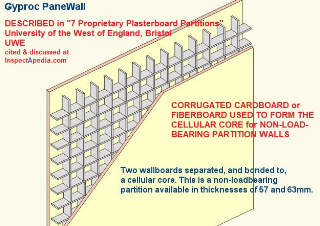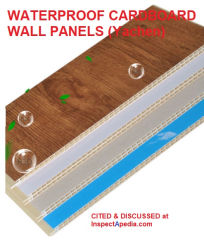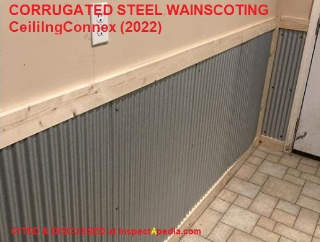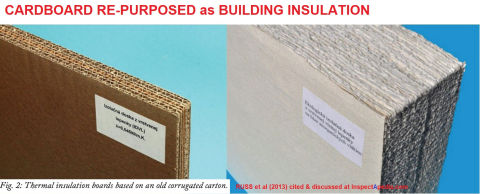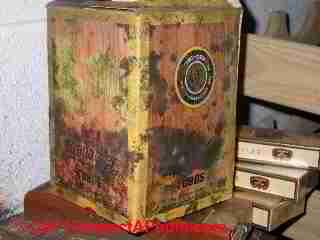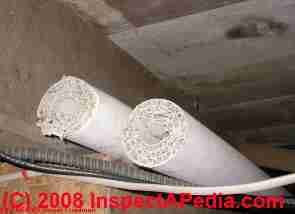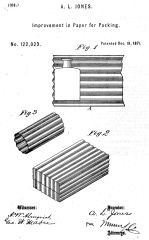 Corrugated Fiberboard (cardboard) Wall & Ceiling Panels
Corrugated Fiberboard (cardboard) Wall & Ceiling Panels
Definition, properties, uses in building construction
- POST a QUESTION or COMMENT about the use of corrugated fiberboard or cardboard in buildings and building construction: egg-box partition walls, PanelWall, Paramount wall properties..
This article describes the history of corrugated cardboard and its use in buildings to form wall or ceiling panels.
Cardboard in corrugated sheet form is credited to Albert Jones (1871) who described an improved packing material for bottles. Our page-top illustration is an excerpt from Jones' corrugated cardboard patent completed in that year.
While mostly used as a box or packing material, corrugated cardboard or similarly formed plastic has found its way into building materials as well, ranging from the most humble cardboard box used by some homeless people, to corrugated panels used on building walls and ceilings, to recycled cardboard insulating panels proposed by some researchers.
InspectAPedia tolerates no conflicts of interest. We have no relationship with advertisers, products, or services discussed at this website.
- Daniel Friedman, Publisher/Editor/Author - See WHO ARE WE?
Corrugated Fiberboard "Cardboard" as a Building Material
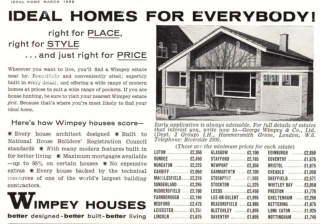 Definition of Corrugated Fiberboard:
Definition of Corrugated Fiberboard:
Corrugated fiberboard is a material consisting of a fluted corrugated sheet and one or two flat liner boards [1] It is made on "flute lamination machines" or "corrugators" and is used for making cardboard boxes.
The corrugated medium sheet and the linerboard(s) are made of kraft container board, a paperboard material usually over 0.01 inches (0.25 mm) thick. Corrugated fiberboard is sometimes called 'corrugated cardboard', although cardboard might be any heavy paper-pulp based board. - Wikipedia (2022)
Illustration: a 1959 Wimpey House advertisement. Wimpey homes built in the U.K. included cardboard-gypsum board laminated panels used to form interior non-load-bearing partition walls.
History of Corrugated Fiberboard or "Cardboard" and Its Use in Buildings
Cardboard has been used in non-load-bearing partition walls in buildings in the UK and in North America since at least the 1950s. More recently cardboard or corrugated fiberboard has been used as an insulating board using re-cycled cardboard (Russ 2013) and also for use as a wood-based sandwich panel used in SIPs or structural insulated panels forming walls or floors (Kawasaki 2006).
The term "fiberboard" is used quite broadly across a range of board-like products made from a variety of source materials, usually wood or plant fibres, but in special cases also including mineral fibers such as "asbestos fiberboard". (Kollman 1975).
Don't confuse corrugated fiberboard or "cardboard" panels in buildings with the more solid or uniform fiberboard panels that also have long history as exterior sheathing, even roof sheathing (questionable), and as interior wall and ceiling surfaces - discussed separately
at FIBERBOARD CEILING & WALL COVERINGS.
The concept of creating a wavy or corrugated surface or form of otherwise flat material such as cardboard lent a property of considerable additional strength as well as an ability to cushion impact that was an important innovation in the use of cardboard for forming boxes and that carried over into additional uses of both paper and other materials shaped into that form.
In addition to its contemporary use as decorative wall coverings, corrugated cardboard has found other uses in buildings well beyond the simple cardboard box. Corrugated cardboard was used both in sheets laminated with gypsum board and also to form a honeycomb core that was in turn laminated with gypsum board to form interior partition walls.
Illustration: Gyproc Panelwall, originally called "Paramount wall" is adapted from and described in the West Oxford University article on proprietary plasterboard partitions cited in detail below.
In North America and in the UK, by 1955 and in response to a surge in demand for residential building materials, cardboard was in use as the interior core of plasterboard produced by several companies including Gyproc (Gyproc-Benelux) for use as a base for wall-plaster suitable for non-load-bearing partitions.
In the U.K., British Gypsum produced PanelWall or Paramount wall partitions comprised of gypsum board laminated to a cardboard core or cardboard "honeycomb" core that acted as a stiffener.
This post-war gypsum board or plaster board was used in Europe and in the U.S. and possibly elsewhere.
Corrugated cardboard core plasterboard panels were produced under the trade names of Gyplank, Gypunit, and Latunit, also Paramount partition board (used by George Wimpey homes in the 1970s), combining plaster with a corrugated fiberboard core. Similar wall panels are called "egg-box partition walls" in the U.K.
In the UK, more than 100,000 Wimpey homes were completed between 1970 and 1980, using Paramont partitions for interior non-load-bearing walls. See the Wimpey Home advertisement from 1959 earlier in this article..
The addition of wax or plastic coatings, for example, produces a "waterproof" cardboard whose uses include wall stickers or wall covering.
The corrugated cardboard shown above, produced by Yachen in China, is sold as a "moisture-proof, anti-static, sound-absorbing, mould-proof, waterproof wall panel. (Alibaba.com)
In references at the end of this article, we cite special difficulties encountered in efforts to re-cycle or re-purpose treated corrugated fiberboard.
Corrugated building products are, of course widely used as a form of other building materials including corrugated fiber cement or asbestos-cement roof and wall panels and corrugated steel panels used in roofing, walls, and even as interior wainscoting (below).
Above: Colorado steel Corrugated Metal "rustic" metal wainscoting from CeilingConnex, advertised by Amazon in March 2022.
History, Ingredients, Manufacture, Uses of Corrugated Fiberboard
 Illustration: early corrugated board patent by Jones (1871) cited below.
Illustration: early corrugated board patent by Jones (1871) cited below.
- Beer, Peter, IMPROVEMENT in PAPER BOXES [PDF] U.S. Patent granted May 16, 1871
- CAMPEAN, TEOFIL, NICOLAE PEIU, and MARIA GAVRILESCU. ALTERNATIVE USES OF PAPER AND CARDBOARD IN ARCHITECTURE AND CONSTRUCTION [PDF] Buletinul Institutului Politehnic Din Iaşi Publicat De Universitatea Tehnică „gheorghe Asachi” Din Iaşi Volumul 66 (70), Numărul 2, 2020 Secţia Chimie Şi Inginerie Chimică
Includes: 2. The Potential of Paper and Cardboard as a Building and Thermal Insulation Material
Abstract.
This paper developed an analysis of the relevant uses of paper and cardboard in construction and architecture, as a basis for information for future studies and research.
In this context, based on data from the literature it is demonstrated that it is possible that cardboard products with sufficient compressive strength can withstand structural loads, thus providing an alternative to the use of traditional construction materials (concrete and steel), in the field construction and architecture.
There is also the potential for the use of cardboard as a material in the construction of assemblies as construction elements, such as panels for walls, roofs and floors, as well as the development of short-lived or temporary buildings.
Some houses are made of waste paper and cardboard and can be recycled for the manufacture of cardboard. These recycling processes involve less energy and clearly less raw materials than the production of many other materials. - D1974 Standard Practice for Methods of Closing, Sealing and Reinforcing Fiberboard Boxes
- D4727 Standard Specification for Corrugated and Solid Fiberboard Sheet Stock (Container Grade) and Cut Shapes
- D5639 Standard Practice for Selection of Corrugated Fiberboard Materials and Box Construction Based on Performance Requirements
- Hutten, Irwin M. & Sujit B asnerjee, REPULPABILITY OF WAXED CORRUGATED BOARD [PDF] Report to the FBA/AF&PA Repulpable Wax Voluntary Standards Task Force Institute Of Paper Science And Technology, Atlanta, Georgia (1994) retrieved 2022/03/18 original source: https://smartech.gatech.edu/bitstream/handle/1853/845/3900_000_09231994.pdf
- Jones, Albert L., IMPROVEMENT in PAPER for PACKING, [PDF] US patent 122,023, issued 1871-12-19
Excerpt:
Beit known that I, ALBERT L. JONES, of New York city, in the county and State of New York, have invented a new and Improved Corrugated Packing-Paper, of which the following is a specification:
The object of this invention is to provide means for securely packing vials and bottles with a single thickness of the packing material between the surface of the article packed; and it consists in paper, card-board, or other suitable material, which is corrugated, crimped, or bossed, so as to present an elastic surface by reason of such corrugated, crimped, or bossed surface, as will be hereinafter more fully described. - Kawasaki, T., Kawai, S., 2006: Thermal insulation properties of wood-based sandwich panel for use as structural insulated walls and flors. J. Wood Sci. 52(1): 75- 83
- Kollmann, Franz FP, Edward W. Kuenzi, and Alfred J. Stamm. FIBERBOARD [PDF] In Principles of Wood Science and Technology, pp. 551-672. Springer, Berlin, Heidelberg, 1975. - retrieved 2022/03/18 original source: https://link.springer.com/chapter/10.1007/978-3-642-87931-9_6
Abstract
There are various types of fiberboard, and unfortunately the terminology is not yet internationally standardized. Neverthelesss, one fundamental definition generally is recognized (FAO, 1958/1959, p. 4):
“Fiberboard is a board generic term encompassing sheet materials of widely varying densities manufactured from refined or partially refined wood fibres or other vegetable fibres. Bonding agents and other materials may be incorporated in the manufacture of the board to increase strength, resistance to moisture, fire or decay or to improve some other property.” In the technical sense the ISO-definition is more precise:
“Sheet material generally exceeding 1.5 mm in thickness, manufactured from ligno-cellulosic fibers with the primary bond from the felting of the fibers and their inherent adhesive properties. Bonding materials and/or additives may be added”.
Excerpt:
The origin of wood fiberboard goes back to Japan where as early as in the 6th century B. C. heavy papers were used for the construction of walls for small houses. In Europe a patent was granted to the British inventor Clay in 1772 for the application of "papier mache" (Neu88er, 1957) not only for use in dwellings, furniture, doors, but also for carriages.
The idea of using the new material for big stiff building elements was evident. Since the middle of the 19th century, the proposals for use of fiberboards have greatly increased. More than 200 patents were issued in this field between 1858 and 1928 (Rossmann, 1928), more than 600 patents until1957 (Neusser, 1957).
In spite of these early developments the actual fiberboard industry started near the beginning of the 20th century in England and in the U.S.A. The development up to 1926 was rather sporadic and without a remarkable increase in capacity. - Kouko, J., J. Lehto, T. Tuovinen, and P. Vahala-Partanen. ON the FOUNDING of the CORRUGATED BOARD INDUSTRY and the introduction of box compression testing: 1871-1914 [PDF] In Progress in Paper Physics Seminar. 2020.
- Matchett, Alexander, IMPROVEMENT in PAPER BOXES [PDF] U.S. patent No. 221,244, granted November 4, 1879
Excerpt:
Be it known that I, ALEXANDER MATCHETT, of Pittsburg, Allegheny county, State of Pennsylvania, have invented an Improvement in Paper Boxes, of which the following is a specification. My invention is a paper box constructed as fully described hereinafter, so as to be cheap, strong, and capable of being easily and almost hermetically sealed and closely packed. In the drawings forming part of this specification, Figure 1 is a perspective view, showing the forms of blanks from which the box is made; Fig. 2, a perspective view of a box, showing one end open; and Fig. 3, a different form of box with tongues. - Manobala, K. S., S. Prabhakaran, D. R. Ramji Gautham, M. Sathish Kumar, A. Bala Ganesan, and C. Nithish. Investigation of mechanical and thermal behaviour of natural sandwich composite materials for partition walls. [PDF] Int J Res Rev 7, no. 5 (2020): 211-6.
Abstract excerpt: ... an attempt has been made to study the mechanical and thermal behaviour of natural composite sandwich made of flax reinforcement and coir as core material. - Poswar Building Materials, Cladding and Sandwich Panels, 1940s - 1950s [web article] retrieved 2022/03/18 original souce: http://postwarbuildingmaterials.be/material/cladding-and-sandwich-panels/ - Vrije Universiteit, Brussel, (Belgium), and other contributors, website authors & contact information was not found. [Ed.]
This article describes the post-war development of wood fiber panels, cardboard-core gypsum panels, and similar products.
Excerpts:
The website and the accompanying book will assist a broad group of stakeholders, ranging from architectural and construction historians, restoration and renovation architects, to building administrators and owners, in recognizing and valorising typical post-war materials. This research will help them to link brand and product names with their fabrication, and understand their applications…
...
Eternit’s regular Gyproc board had ivory paper on the front side, ready for painting or covering with wall paper, while the paper on the other side was grey. Boards came sized 120 or 122 cm wide and between 183 and 365 cm long. The boards were 9.5 or 12.7 mm thick and weighed approximately 8.5 or 10.4 kg/m². In addition to its insulating capacities (the λ-value varied between 0.16 and 0.21 W/mK), a Gyproc board was also resistant to fire.
...
Eternit and Gyproc-Benelux became the Belgian market leader in plasterboards and similar products in the post-war period. Among the few other companies producing prefabricated plasterboards was Porelith Belge, which made porous plasterboard tiles called Porelith, and Fabribeton, manufacturer of the patented system Pro-monta. The latter consisted of thick plasterboard tiles that were to be stacked like masonry and connected with liquid plaster in the hollowed edges.
- Rentetzi, Maria. CARDBOARD BOX, the POLITICS of MATERIALITY [PDF] Mattering Press (2020): 443.
Above: recycled cardboard re-purposed for use as thermal insulation or building insulating panels. The authors, Russ et al 2013, discuss preparation of the insulating board from recycled cardboard and also management of technical difficulties such as moisture control.
- Russ, Albert, Juraj Schwartz, Štefan Boháček, Henrich Lübke, Vladimír Ihnat, Andrej Pažitný, REUSE OF OLD CORRUGATED CARDBOARD IN
CONSTRUCTIONAL AND THERMAL INSULATING
BOARD [PDF] (2013), Pulp and Paper Research Institute,
Bratislava, Slovak Republic, retrieved 2022/0318 original source: http://www.woodresearch.sk/wr/201303/17.pdf
Abstract:
Due to the absence of larger company which treats the waste paper from corrugated fiberboard and old corrugated cardboards in Slovakia today, the large amount of this waste paper grade has not been utilized.
One of the possibilities is to produce structural or thermal and insulation boards from this waste material. In this paper the production methods of various board grades depending on method of their use are introduced.
Their properties of the utility are rated. Structural boards can be used in furniture industry, in production of thermal and insulation boards suitable for thermal insulation of buildings or as building blocks, e.g. in partition walls.
KEYWORDS: Old corrugated cardboard (OCC), construction core board, thermal insulating board, flexural strength, composition optimalization. - Van Iersel, Taco, and Elise Van Dooren. "Application of cardboard in partitioning." Mick Eekhout, Fons Verheijen, Ronald Visserm (Editors), Cardboard in Architecture (2008): 119.
- VOLUNTARY STANDARD for REPULPING & RECYCLING CORRUGATED FIBERBOARD treated to improve its performance in the presence of water and water vapor [PDF] (2007) web.archive.org
Excerpt:
Disposing of treated corrugated that cannot be recycled can be a financial and logistical burden on the supply chain for these packages.
And, while treated corrugated containers are the most practical and cost-effective way to ship produce, meats, seafood and other items, certain treatments to improve performance in the presence of water or water vapor have made recycling difficult. It is desirable from both increased recyclable fiber availability and environmental standpoints to encourage the development of treated corrugated that may be recycled into other paper products using common mill technology.
The corrugated products industry recognizes the solution to this problem should be industrywide, primarily because the recycling mills cannot effectively identify all treatments specific to particular companies. Different treatment systems may have different impacts on recycling processes; mill operators have even considered some to be highly detrimental.
- West Oxford University, 7 PROPRIETARY PLASTERBOARD PARTITIONS [PDF] University of West of England,UWE Bristol, retrieved 2022/03/18 original source: https://vleweb.ccn.ac.uk/constructionweb/finishes/partitions/section7.htm
- Wikipedia, "Corrugated Fiberboard", retrieved 2022/03/18, original source: https://en.wikipedia.org/wiki/Corrugated_fiberboard
...
Reader Comments, Questions & Answers About The Article Above
Below you will find questions and answers previously posted on this page at its page bottom reader comment box.
Reader Q&A - also see RECOMMENDED ARTICLES & FAQs
Does the Vintage Cardboard Wood paneling in my house contain asbestos?
Twenty five years ago I purchased my 1863 Victorian three story home that has a cement block addition probably built in the early 1960’s or 1950’s. The walls are wallpapered over and I though they were wood paneling underneath.
After a water leak around a brick chimney that leaked down into the room, I removed a strange corrugated cardboard like wall paneling with a black paper backing underneath.
The seams of each panel were covered with thin wood on strips that run vertical. The whole room about 20’X15’ are covered in it. The floor is solid oak but was built directly above the ground with support beams the run directly down into the dirt maybe three feet off the ground.(a cold floor!)
This large family room is part of the most used portion of the home as it connects directly into our kitchen and breakfast nook that both were added on from the main home when they removed a back porch that had a brick base. All rooms are open to each other with doorways but no doors on them.
My fear of removing the rest of the “cardboard wall panels” is not knowing what I will find behind them or what they are even made out of. Who knows what I may be exposing the rest of the open living area if I remove it. I am having an electrician come to update the old wiring that runs through those rooms.
The previous owners wallpapered everything in site, even the family room ceiling. It definitely is not drywall behind it up there either. Feels like regular wood paneling used backwards to create a smoother surface.
Believe it or not, this home was previously owned by a family doctor who served my community all his life. Interior looks sure can be deceiving.
Any ideas on this subject are appreciated. I am not in a financial situation to tear down the addition or I would have done so many years ago. - Anonymous by private email 2022/03/18
Moderator reply:
Thanks for the interesting question. I could perhaps be more useful in researching and answering if you could
- attach some photos of the material showing its face, edges, and any other details you may have
- tell me the location - country & city - of the home
Typically corrugated fiberboard or "cardboard" wall panels would not be expected to contain asbestos when used as simple ceiling or wall panels, but indeed there were definitely corrugated asbestos paper products - often among the few asbestos materials that can be reliably identified by eye, without lab testing.
An example - in the form of corrugated asbestos paper pipe insulation is shown below.
Details of that material are at ASBESTOS PIPE INSULATION
1960 built council house in Hampshire, England. Hexagonal paper or cardboard wall panels
I have a 1960 built council house in Hampshire, England. I work in houses everywhere but have never come across internal walls like mine. They are constructed with w450mm x d100mm wide floor to ceiling panels made from solid plaster containing horse hair .
The panels have a hexagonal structure inside made from the same plaster with small slots to let air circulate within the structure.
Each panel is cemented together with plaster and tied to the outside wall with wall ties. Anybody know what this stuff is?
Thanks - On 2016-12-24
by Steve H -
Reply by mod
Indeed we've found, photographed and documented cardboard panels used as wallboard for a plaster base in both the UK and in the U.S. They're called egg-box partition walls.
Details are above on this page.
...
Continue reading at FIBERBOARD SOUND INSULATION, or select a topic from the closely-related articles below, or see the complete ARTICLE INDEX.
Or see these
Recommended Articles
- BARN ROOFING, METAL
- CANEBOARD PANELS
- CORRUGATED ROOFING
- FIBERBOARD CEILING & WALL COVERINGS
- FIBERBOARD, LOW DENSITY, ASBESTOS PRODUCTS
- FIBERBOARD ROOFING & FIBER-WOOD ROOFING - home
- FIBERBOARD SHEATHING IDENTIFICATION
- FIBERBOARD SOUND INSULATION
- HARDBOARD Masonite™-like INGREDIENTS
- INSULATION IDENTIFICATION GUIDE - home
- MDF Medium-Density Fiberboard DEFINITION & CHARACTERISTICS
- MOLD on CARDBOARD such as boxes
- SHEATHING, FIBERBOARD - home
- STEEL & IRON BUILDING SIDING
Suggested citation for this web page
CARDBOARD CORRUGATED FIBERBOARD at InspectApedia.com - online encyclopedia of building & environmental inspection, testing, diagnosis, repair, & problem prevention advice.
Or see this
INDEX to RELATED ARTICLES: ARTICLE INDEX to BUILDING INSULATION
Or use the SEARCH BOX found below to Ask a Question or Search InspectApedia
Or see this
INDEX to RELATED ARTICLES: ARTICLE INDEX to BUILDING INTERIORS
Or use the SEARCH BOX found below to Ask a Question or Search InspectApedia
Ask a Question or Search InspectApedia
Try the search box just below, or if you prefer, post a question or comment in the Comments box below and we will respond promptly.
Search the InspectApedia website
Note: appearance of your Comment below may be delayed: if your comment contains an image, photograph, web link, or text that looks to the software as if it might be a web link, your posting will appear after it has been approved by a moderator. Apologies for the delay.
Only one image can be added per comment but you can post as many comments, and therefore images, as you like.
You will not receive a notification when a response to your question has been posted.
Please bookmark this page to make it easy for you to check back for our response.
IF above you see "Comment Form is loading comments..." then COMMENT BOX - countable.ca / bawkbox.com IS NOT WORKING.
In any case you are welcome to send an email directly to us at InspectApedia.com at editor@inspectApedia.com
We'll reply to you directly. Please help us help you by noting, in your email, the URL of the InspectApedia page where you wanted to comment.
Citations & References
In addition to any citations in the article above, a full list is available on request.
- In addition to citations & references found in this article, see the research citations given at the end of the related articles found at our suggested
CONTINUE READING or RECOMMENDED ARTICLES.
- Carson, Dunlop & Associates Ltd., 120 Carlton Street Suite 407, Toronto ON M5A 4K2. Tel: (416) 964-9415 1-800-268-7070 Email: info@carsondunlop.com. Alan Carson is a past president of ASHI, the American Society of Home Inspectors.
Thanks to Alan Carson and Bob Dunlop, for permission for InspectAPedia to use text excerpts from The HOME REFERENCE BOOK - the Encyclopedia of Homes and to use illustrations from The ILLUSTRATED HOME .
Carson Dunlop Associates provides extensive home inspection education and report writing material. In gratitude we provide links to tsome Carson Dunlop Associates products and services.


